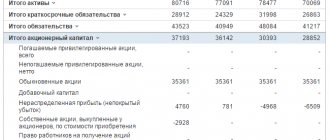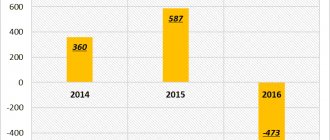What is an organization's equity
This is a financial indicator that characterizes the amount of funds belonging to the participants of the organization.
The definition of equity capital (SC) is given in paragraph 66 of the Regulations on accounting and financial reporting (approved by order of the Ministry of Finance dated July 29, 1998 No. 34n). It says that the IC includes:
- capitals: authorized (share), additional, reserve;
- retained earnings;
- other reserves.
REFERENCE
Essentially, equity capital (also called equity) is the company's assets minus its liabilities. Another indicator is determined in a similar way - the value of the organization’s net assets (clause 4 of the Procedure for determining the value of net assets, approved by Order of the Ministry of Finance dated August 28, 2014 No. 84n). Therefore, the concepts of “equity” and “net assets” are often equated.
Assess your organization's financial condition and get tips on how to improve it
The essence of the term “equity capital”
When characterizing equity capital as an object of economic analysis, two options for its definition are most often given:
- the value of the enterprise's assets unencumbered by the presence of external liabilities;
- a list of sources of financing the organization’s activities that make up the amount of its capital.
The first interpretation is often given in legal acts issued by government agencies:
- in Art. 35 Federal Law “On Joint Stock Companies” dated December 26, 1995 No. 208-FZ for institutions of the credit and financial sector it is proposed to calculate the value of equity capital, and not net assets;
- in paragraph 29 of the order of the Ministry of Agriculture of the Russian Federation dated January 20, 2005 No. 6, attention is drawn to the fact that the amount of equity capital is the difference between the assessment of all assets and liabilities of the company, or, in other words, is identical to the term net asset value.
It can be seen that the recognition of the equivalence of the terms equity and net assets is justified, and both of these categories are defined as the difference between the assets and liabilities of a business entity.
The following version of the description of equity in the balance sheet is a combination of elements:
- authorized, additional, reserve fund;
- volume of shares purchased from shareholders;
- retained earnings of the company;
- amounts of revaluation of fixed assets and intangible assets.
All elements are reflected on pages 1310–1370 of the balance sheet. This idea fits well into the global theory of determining the size of equity capital.
The choice of method for calculating equity capital depends on the tasks facing the specialist performing the calculation. In this case, quite often it is necessary to take into account the wishes of investors, credit institutions or company owners. Management’s own views have a significant influence on the choice of algorithm.
Methods for calculating equity capital
In practice, two methods are usually used.
The first one is very simple. Its essence is to take the figure indicated in a certain line of the balance sheet as the value of the capital account.
The second method is a little more complicated. It is based on the equality of the concepts of “equity” and “net assets”. For calculations, you must use the procedure for calculating net assets approved by the Ministry of Finance. Take the resulting value as the SC. Note that for the second method (as for the first), the data sources are balance sheet indicators.
Results
An idea of the amount of equity in the balance sheet is given by the value indicated in its line 1300. However, in its essence, equity corresponds to the concept of “net assets”.
To calculate net assets, there is a formula approved by the Russian Ministry of Finance, based on balance sheet data, but taking them into account taking into account some nuances. The amount of equity capital is extremely important for assessing the financial position of the company. Of particular importance is its relationship with the size of the authorized capital. You can find more complete information on the topic in ConsultantPlus. Free trial access to the system for 2 days.
Which line of the balance sheet contains the equity indicator
To apply the first method, you need to know where the company's own funds are reflected on the balance sheet. In the liability, in line 1300 “TOTAL capital”. The number in this line is the sum of the indicators of six lines.
- 1310 “Authorized capital (share capital, authorized capital, contributions of partners).”
- 1320 “Own shares purchased from shareholders.”
- 1340 “Revaluation of non-current assets”.
- 1350 “Additional capital (without revaluation).”
- 1360 “Reserve capital”.
- 1370 “Retained earnings (uncovered loss).”
Fill out and print the balance sheet using the current form in the web service Fill out for free
What is included in the company's equity capital?
In economic science, as well as in legal practice - Russian and world - several approaches to determining the essence of equity capital . The most common in the Russian Federation are those that define equity as:
- equal to net assets;
- equal to the amount of authorized, additional, reserve capital, retained earnings and amounts paid for the repurchase of shares.
Let us study the features of the application of each of the noted approaches to defining the concept of equity capital in more detail.
Net Worth Formula
To apply the second method, you need to use a formula that determines the value of net assets. This formula is enshrined in Order No. 84n of the Ministry of Finance dated August 28, 2014.
SC = ASSETS (minus receivables of the founders for contributions to the authorized capital) - LIABILITIES (minus deferred income associated with receiving government assistance)
Table
Decoding the indicators involved in the formula
| Index | Decoding |
| ASSETS | Numbers from balance line 1600 “BALANCE (asset)” |
| Accounts receivable from founders for contributions to the authorized capital | Debit balance on account 75 “Settlements with founders” subaccount “Settlements on deposits in the management company” |
| OBLIGATIONS | The sum of the indicators in two lines of the balance sheet: 1400 “TOTAL long-term liabilities” and 1500 “TOTAL short-term liabilities” |
| Deferred income related to receiving government assistance | Credit balance of account 98 “Deferred income” sub-account “Gratuitary receipts from the budget” |
A line in the balance sheet reflecting the amount of equity capital
Having chosen the standard method as the preferred approach to solving the issue of calculating the volume of equity capital, it is enough to use the data from page 1300. That is, just take the result of the 3rd section:
SK = line 1300 f. No. 1.
If the company is interested in using the calculation of net assets, then equity capital in the balance sheet is not just a single value from page 1300, but a full-fledged calculation with several variables in its composition. Let's look at how this calculation is done in the next section.
Optimal average equity capital
This indicator must be equal to or exceed the amount of the authorized capital (AC) of the company. If this condition is met, the business can be called successful.
IMPORTANT
By law, it is prohibited to allow the equity capital of an LLC to be less than the authorized capital. When faced with such a situation, society must take one of two paths. Either increase net assets to the level of the authorized capital, or reduce the authorized capital to the amount of net assets. If, as a result, the capital company turns out to be less than the minimum established by law (10,000 rubles), the LLC will have to be liquidated (clause 4 of article 4 of the Civil Code of the Russian Federation).
Get a sample accounting policy and do accounting in a web service for small LLCs and individual entrepreneurs Get it for free
Sometimes financiers use the following approach to determine the optimal average amount of equity capital. Add up the value of assets with minimal liquidity (these usually include inventories, non-current assets and work in progress). Own capital must be equal to or greater than the value found.
The best value of the equity indicator
The result obtained as a result of calculations according to the instructions of the Ministry of Finance must be at least greater than zero. If the displayed value is less, the company has problems associated with excessive lending or insufficient quickly salable assets.
For the purpose of analytical research, a simple average of equity values at the beginning and end of the year is most often used. It can be represented in the form of a formula:
SK Wed. = (SK1 + SK2) / 2.
A result exceeding the authorized capital will be considered good. This is due to the fact that any successful business must be accompanied by an increase in equity capital through efficient, profitable activities.
IMPORTANT! If the option of calculating net assets is chosen as an approach to determining the amount of equity capital, then the result obtained cannot be less than the amount of the authorized capital. Otherwise, the JSC or LLC will be required to increase the received value to the amount of the authorized capital, or the tax authorities will have the right to initiate the liquidation procedure of the company.
Analytical indicators
Among the informative indicators taken into account when assessing debt capital on the balance sheet are:
- debt ratio. The calculation of this value corresponds to the formula:
- D – amount of debt obligations, t.r.;
- EBTIDA is an analytical indicator defined as the difference between the company’s profit before interest, taxes and depreciation, etc.
The standard for this coefficient is defined within the range of 2-2.5. Debt can be considered long-term loans and borrowings (in international practice), short-term loans and borrowings (in Russian practice).
- indicator of financial leverage (debt capital ratio on the balance sheet), which is determined by the formula:
- DO – long-term liabilities, t.r.;
- KO – short-term liabilities, t.r.;
- SK – equity capital, t.r.
The recommended standard is 0.25 – 1. With a value of 0.25, we can conclude that the debt load is favorable for the company, which indicates a positive assessment of its creditworthiness. With a value close to 1, the load is considered maximum. If the value of the debt capital ratio according to the formula on the balance sheet goes beyond 1, then creditworthiness is assessed negatively.
- share of financing of fixed assets through long-term loans:
where VA – non-current assets, i.e.
Attracting loans to finance fixed assets is justified, since these amounts are repaid further due to the cash flows created by these fixed assets.
- the ratio of working capital and short-term loans is determined by the formula:
where OA is the company’s working capital, i.e.
The standard for this indicator varies from 1.5 to 2.
As a result of analyzing these indicators regarding the use of debt obligations of the company, it is possible to draw a conclusion about its creditworthiness. The information base obtained on the basis of calculating the presented indicators also allows management to develop a number of measures aimed at increasing the creditworthiness of the company.
Total assets on balance sheet
The balance sheet reflects the state of the property operated by the company and the capital through which it is formed as of a certain date. Assets are:
non-current (fixed assets, intangible assets, investments). They are accumulated in the 1st section of the balance sheet;
circulating (cash, inventories, debts of debtors). The 2nd section of the balance sheet is allocated for this share of property.
All of them are recorded on the left side of the balance sheet – its asset. The total amount of non-current assets (VA) is indicated in line 1100, current assets (OA) - in line 1200. Their amount on the balance sheet is reflected in line 1600, i.e. the formula for calculating the total (also called gross) value of assets is extremely simple:
Announced and placed shares
The authorized capital of a joint stock company is the nominal value of shares that are purchased by shareholders or placed among shareholders. But in the charter of a joint stock company, in addition to the authorized capital, or the par value of the placed shares, by decision of the general meeting of shareholders, it is possible to provide for the possibility of additional issue of shares in the event that it is necessary to increase the authorized capital.
The meaning of the data
This right usually consists in the fact that shareholders' meetings take place once a year; convening an extraordinary meeting requires additional costs and time. Therefore, shareholders, planning that during the year the company will need to increase the authorized capital one or more times in connection with some production projects or in order to ensure conversion into ordinary shares, provide in the charter the possibility of issuing shares, called authorized ones, in excess of their allocated number , however within certain limits.
A joint stock company, within the limits of the size of authorized shares, may make repeated decisions to issue additional shares in excess of those placed. In addition, these actions can be taken by the decision of the general meeting by the board of directors of the joint-stock company without convening extraordinary meetings of shareholders. As a result, the procedure for increasing the authorized capital becomes quite flexible in accordance with changing market conditions and requires much less time, which is an important factor for competition in the market.
Retained earnings (uncovered loss) in the balance sheet
As a result of the company's activities, profit or loss arises in the form of the difference between income and expenses. The indicator is taken into account continuously, taking into account the results of activities for the reporting periods. Distributed by decision of the owners, taking into account the results of activities of previous periods.
The amount of retained earnings (losses) may increase due to the receipt of net profit, bringing the capital company to the value of net assets, and restoration of the amounts of unclaimed dividends. The amount is reduced in connection with the receipt of losses, the transfer of part of the profit to the reserve fund, an increase in the capital at the expense of the article or for the payment of dividends.
An example of how profit is reflected on the balance sheet. An enterprise in the form of an LLC had, as of January 1, retained earnings in the amount of 20,000 rubles. The founders decided to refuse to pay dividends. Based on the results of the activity, a loss of 5,000 rubles was received. The amount of retained earnings at the end of the reporting date amounted to 15,000 rubles.
The indicator of uncovered losses on the balance sheet is negative, indicating the lack of reserve capital in the company. Based on data from one period, conclusions about the sustainability of the enterprise are not drawn. The profit received in the future will cover the existing losses. There is rarely a significant amount of profit on the balance sheet. The positive difference is distributed between the founders and shareholders or used for the development of the company.









